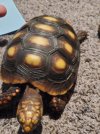bluewolf85
New Member
I rescued this little girl back in November who had pneumonia and was not eating for over 2 months, was only 190 grams and wasn't using her legs very well. Thanks to my wonderful vet and some better husbandry we've gotten her back to eating and now she's a healthy 280ish grams (she goes between 280-300 grams) and running around like a happy little tort. We are still working on her eating habits as she mostly only likes mazuri pellets but she's expanded her menu to various greens if chopped tiny and mixed with mazuri, squash baby food, bananas, strawberries, mango, blueberries, raspberries, clover sprouts and some rare simple protein cat food (we are trying to get her to try a different protein still - haven't been able to try eggs yet due to the shortage).
My question is really about her shell. Is it normal? I think she may be approx 1.5 -2 years old (?) and I'm worried she developed some mild to moderate MBD before I got her, not enough to develop a soft shell but her scoots almost look indented and she's not totally smooth but not pyramiding. I'm a seasoned reptile keeper (and I work as a nurse for an exotic veterinarian) but this is actually my first tort.
My question is really about her shell. Is it normal? I think she may be approx 1.5 -2 years old (?) and I'm worried she developed some mild to moderate MBD before I got her, not enough to develop a soft shell but her scoots almost look indented and she's not totally smooth but not pyramiding. I'm a seasoned reptile keeper (and I work as a nurse for an exotic veterinarian) but this is actually my first tort.



